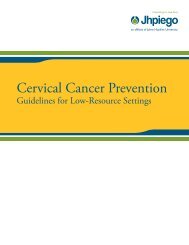Manual for Male Circumcision under Local Anaesthesia
Manual for Male Circumcision under Local Anaesthesia
Manual for Male Circumcision under Local Anaesthesia
Create successful ePaper yourself
Turn your PDF publications into a flip-book with our unique Google optimized e-Paper software.
<strong>Male</strong> circumcision <strong>under</strong> local anaesthesia<br />
Version 3.1 (Dec09)<br />
BASIC CONCEPTS<br />
Measures to prevent infection in male circumcision programmes have two<br />
primary objectives:<br />
• to minimize the risk of infections in people having surgery;<br />
• to minimize the risk of transmitting HIV and other infections to clients and<br />
health care staff, including cleaning and housekeeping staff.<br />
In the context of circumcision services, there are two important pathways <strong>for</strong><br />
transmission of infection:<br />
• Direct transmission. Enteric and skin infections can be transmitted by<br />
this route, as can bloodborne pathogens, such as HIV and hepatitis B<br />
virus, either by direct contact with an open wound or blood, blood<br />
products and body fluids, or by accident through a needle stick injury.<br />
• Airborne transmission. Pneumonia, pertussis, diphtheria, influenza,<br />
mumps, and meningitis can be transmitted through droplets in the air,<br />
usually within a range of about 1 m, while active pulmonary tuberculosis,<br />
measles, chickenpox, pulmonary plague, and haemorrhagic fever with<br />
pneumonia can be transmitted via droplet nuclei (small-particle aerosols)<br />
over larger ranges.<br />
In male circumcision programmes, a major concern is the potential direct<br />
transmission of bloodborne pathogens, such as HIV and hepatitis B virus, to<br />
health care workers or patients. Exposure may take place during patient care,<br />
clinical or surgical procedures, processing of soiled instruments, cleaning and<br />
waste disposal. Needle-stick injuries carry a high risk of infection; the actual<br />
level of risk will depend on the type of needle, the depth of the injury, the<br />
amount of blood or blood product on the needle, and the viral load in the<br />
blood.<br />
The risk of acquiring HIV from an HIV-infected person through a needle-stick<br />
injury is estimated at 0.3% (three HIV infections <strong>for</strong> every 1000 injuries). The<br />
risk of acquiring hepatitis B virus infection, after being stuck with a needle that<br />
has been used on a person with hepatitis B infection ranges from 6% to 37%,<br />
with an average of 18%. Finally, the risk of acquiring hepatitis C infection after<br />
being stuck with a needle that has been used on a hepatitis-C-infected person<br />
is 1.8%. 1<br />
Most instances of transmission of infection in health care facilities can be<br />
prevented through the application of basic infection control precautions. In the<br />
circumcision clinic, standard precautions, as described below, should be<br />
applied to all patients at all times, regardless of their infection status.<br />
Prevention of Infection Chapter 8-2
















